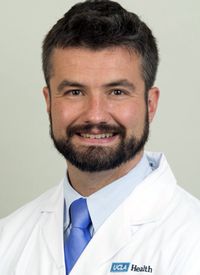Proposed Phase II Trial Aims to Explore Optune System in Grade III Recurrent Glioma
Researchers are hoping that a proposed phase II study exploring use of the Optune system in patients with recurrent grade III malignant glioma will expand the indications for the tumor treating fields device.
Daniel O’Connell, MD

Daniel O’Connell, MD
Researchers are hoping that a proposed phase II study exploring use of the Optune system in patients with recurrent grade III malignant glioma will expand the indications for the tumor treating fields (TTFields) device beyond its current FDA-approved use in recurrent grade IV glioblastoma.
Daniel O’Connell, MD, a neuro-oncologist at UCLA’s Geffen School of Medicine, discussed his proposal withTargeted Oncologyat the 21st Annual Scientific Meeting of the Society of Neuro-Oncology (SNO) held November 17 to 20, 2016 in Scottsdale, Arizona.
Patients with grade III progressive or recurrent anaplastic glioma represent an unmet clinical need, O’Connell noted in his presentation at SNO. These patients have poor median survival despite available chemotherapy, and when they recur after temozolomide, no standard of care options are currently available to them. Choice of therapy is up to the physician, but most often the regimen includes bevacizumab, he added.
O’Connell and his colleagues will evaluate whether TTFields may provide a new option for these patients. It is a noninvasive, regional, antimitotic treatment that delivers low-intensity, intermediate-frequency, alternating electric fields to tumors through transducer arrays placed on the scalp. He cited the “buildup of evidence in favor of the use of tumor treating fields,” both with respect to the system’s better side-effect profile and accumulating evidence favoring prolonged survival.
The study’s primary objective is to determine the efficacy of Optune in patients with recurrent malignant glioma based on 6-month progression-free survival (PFS). Secondary objectives include evaluating the safety and efficacy of Optune in this group of patients and to determine if the treatment has a significant impact on their quality of life using the Functional Assessment of Cancer Therapy (FACT) questionnairesFACT-Brain and FACT-Cognitive Function.
With currently no known biomarker to signal which patients may have a better response to Optune technology, another secondary aim of the study is to determine whether the presence of theATRXand/or theIDH1mutation in tumor specimens improves treatment response. The investigators will also use CytoScan analysis to explore whether the presence of proneural or mesenchymal phenotype yields a better response to the device, and they will assessin vitrosensitivity of the glioma cells in each patient’s tumor samples before and after TTFields to see if there is a correlation with treatment response.
O’Connell plans to enroll at least 26 patients, with a maximum of 36, who have had no prior treatment with bevacizumab or any experimental agents. TTFields will be administered with a monthly adherence rate goal of>75% of therapy over a 4-week cycle. MRIs will assess patients for tumor response and disease progression using RANO 2010 criteria to evaluate radiographic response rate, PFS, and overall survival.
“We want to keep our patients naïve for the purpose of the TTFields,” said O’Connell. “This is a different modality than immunotherapy, targeted therapy, and traditional chemotherapy, in that it utilizes a novel mechanism; it is not ionizing radiation, and it is distinct from radiation therapy.”
He said that he expects the FDA will give the go-ahead to use the TTFields system in the grade III setting in the next few months. After that, he would like to start enrolling patients in the single-arm trial, which already has funding and he anticipates will continue through 2020.
“We expect this trial to last for years because these patients, regardless of therapies, typically live about 5 to 7 years, so the use of this will hopefully push us over to that 9-year markthat’s our hope, of course, for these patients.”
While the device is showing promise, O’Connell said that it is yet to be determined how things will go with the technology. He added that there are patients, especially younger patients, who are looking for different treatment options.
“It’s a work in progress in our community in neuro-oncology,” he said. “The data clearly suggest that there is a benefit with this device and therefore should be used in patients who are willing to use it.”
Reference:
Connell D, Carrillo J, Kong XT, et al. A phase II, single arm study of Optune® in bevacizumab-naive subjects with recurrent who grade III malignant glioma.Neuro-Oncology. 2016; 18:abstract ACTR-41.
FDA Approves FoundationOne CDx as Companion Diagnostic for Tovorafenib in Pediatric Low-Grade Glioma
January 17th 2025FoundationOne CDx is now FDA-approved as the first companion diagnostic for tovorafenib, enabling targeted treatment for relapsed/refractory pediatric low-grade glioma with BRAF mutations or rearrangements.
Read More